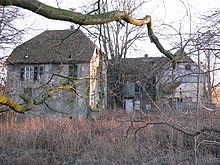Ellerburg
The Ellerburg was a moated castle in the village of Fiestel in the city of Espelkamp in the Minden-Lübbecke district . The castle complex was east of the Great Aue and north of the Mittelland Canal at the transition from the Alsweder Niederung to the Rahdener Geest and was around four hectares in size. Their buildings were badly dilapidated and in danger of collapsing and were therefore torn down to the foundation walls.
The Ellerburger Wiesen nature reserve consists largely of the property's former agricultural land.
history
The estate was first mentioned in 1475. The owner at that time was Hardecke von Münch . In 1510 the estate was divided between the two sons. In addition to the Ellerburg, it was the neighboring Benkhausen Castle . Imperial and Swedish troops faced each other in 1633 in a battle over the castle.
After a long dispute, the Ellerburg came to the von Ripperda family in female succession . The family spread over eastern Holland and the Emsland to the diocese of Minden (Ellerburg). This was achieved not least through targeted marriage. The Prussian officer Friedrich Wilhelm Freiherr von Ripperda had the building rebuilt around 1795. At times he was stationed in the Minden fortress .
As the von Ripperda family got into financial difficulties, the former Minden regional president Freiherr Karl von der Horst acquired the estate in 1825, although he himself had been put into temporary retirement on February 24, 1825 due to deranged financial circumstances. His son Adolf von der Horst held the office of district administrator of the Lübbecke district from 1838 to 1870, mainly from Ellerburg. From 1840, however, he lived at Hollwinkel Castle . The estate was owned by the von der Horst family until the 1990s and is now owned by the city of Espelkamp.
After various initiatives had campaigned for the preservation of the building, which had long been in danger of collapsing, it was decided in March 2012 to demolish the building. The park and parts of the ruins should be preserved. In May 2014 the demolition excavator came and the castle was laid down to the foundation walls.
Ellerburg manor district
Around 1856, an Ellerburg manor district, which was treated as a parish, was newly formed in the Alswede district by being separated from the Alswede parish . On October 1, 1928, it was dissolved and incorporated into the then municipalities of Alswede (larger part) and Hedem .
Building and park
Originally the mansion was on a small island . The courtyard could be reached via a representative stone bridge. The "Ellerburger Mühle" located north of the manor belonged to the estate. In 1595 Johann Monnich transferred it to Ellerburg for the purpose of settling his debts to Curdt von Aßweide, senior of the cathedral chapter in Minden. The watermill, which was driven by the dammed floodplain of the Große Aue, is part of the Westphalian Mühlenstraße .
A chestnut avenue that runs along the southeastern edge of the site originally connected the Ellerburg with Hollwinkel Castle. In the area of the building there are three very old linden trees, particularly the 400 year old linden tree in the courtyard.
Individual evidence
- ↑ Westfalen-Blatt: Espelkamp: "Timetable" for Ellerburg development; Landscape architect Wolfgang Hanke presents park maintenance work to the urban development committee ( Memento from December 3, 2013 in the Internet Archive )
- ↑ Stephanie Reekers: The regional development of the districts and communities of Westphalia 1817-1967 . Aschendorff, Münster Westfalen 1977, ISBN 3-402-05875-8 , p. 230 .
literature
- Gerhard Dallmann: The linden trees smell lovely and lind. "1000-year-old" linden trees in Minden-Ravensberg-Lippe - legends and reality. G. Dallmann, Herford / Hiddenhausen 2001, ISBN 3-9807651-0-5 .
Web links
- Entry on Ellerburg in the scientific database " EBIDAT " of the European Castle Institute
- Archive NRW
- Regional Association Westphalia-Lippe: Former Ellerburg Manor Park in LWL GeodataKultur
- Action plan including the open spaces PDF
- Reconstruction drawing by Wolfgang Braun
Coordinates: 52 ° 21 ′ 11 " N , 8 ° 33 ′ 34" E



